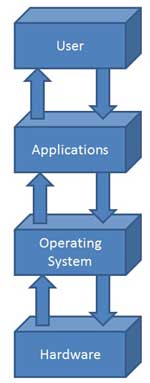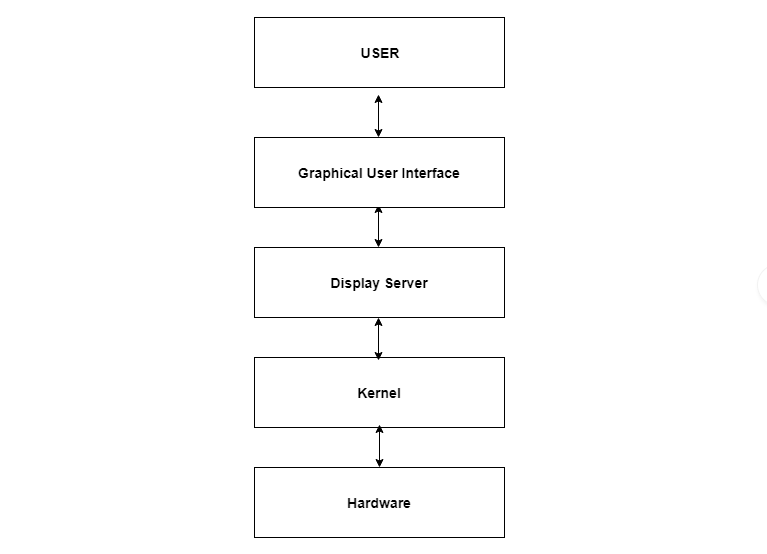MBA
Operating System
·
An operating system is a program that acts as an interface between
the software and the computer hardware.
·
It is an integrated set of specialized programs used to manage
overall resources and operations of the computer.
·
It is a specialized software that controls and monitors the
execution of all other programs that reside in the computer, including
application programs and other system software.

Objectives of Operating System
The objectives of the operating system are −
- To make the computer system convenient to use in an efficient manner.
- To hide the details of the hardware resources from the users.
- To provide users a convenient interface to use the computer system.
- To act as an intermediary between the hardware and its users, making it easier for the users to access and use other resources.
- To manage the resources of a computer system.
- To keep track of who is using which resource, granting resource requests, and mediating conflicting requests from different programs and users.
- To provide efficient and fair sharing of resources among users and programs.
Characteristics of Operating System
Here is a list of some of the most prominent characteristic features of Operating Systems −
- Memory Management − Keeps track of the primary memory, i.e. what part of it is in use by whom, what part is not in use, etc. and allocates the memory when a process or program requests it.
- Processor Management − Allocates the processor (CPU) to a process and deallocates the processor when it is no longer required.
- Device Management − Keeps track of all the devices. This is also called I/O controller that decides which process gets the device, when, and for how much time.
- File Management − Allocates and de-allocates the resources and decides who gets the resources.
- Security − Prevents unauthorized access to programs and data by means of passwords and other similar techniques.
- Job Accounting − Keeps track of time and resources used by various jobs and/or users.
- Control Over System Performance − Records delays between the request for a service and from the system.
- Interaction with the Operators − Interaction may take place via the console of the computer in the form of instructions. The Operating System acknowledges the same, does the corresponding action, and informs the operation by a display screen.
- Error-detecting Aids − Production of dumps, traces, error messages, and other debugging and error-detecting methods.
- Coordination Between Other Software and Users − Coordination and assignment of compilers, interpreters, assemblers, and other software to the various users of the computer systems.
Types of Operating System
Operating systems are there from the very first computer generation and they keep evolving with time. In this chapter, we will discuss some of the important types of operating systems which are most commonly used.
1. Batch operating system
The users of a batch operating system do not interact with the computer directly. Each user prepares his job on an off-line device like punch cards and submits it to the computer operator. To speed up processing, jobs with similar needs are batched together and run as a group. The programmers leave their programs with the operator and the operator then sorts the programs with similar requirements into batches.
The problems with Batch Systems are as follows −
- Lack of interaction between the user and the job.
- CPU is often idle, because the speed of the mechanical I/O devices is slower than the CPU.
- Difficult to provide the desired priority.
2. Time-sharing operating systems
Time-sharing is a technique which enables many people, located at various terminals, to use a particular computer system at the same time. Time-sharing or multitasking is a logical extension of multiprogramming. Processor's time which is shared among multiple users simultaneously is termed as time-sharing.
The main difference between Multiprogrammed Batch Systems and Time-Sharing Systems is that in case of Multiprogrammed batch systems, the objective is to maximize processor use, whereas in Time-Sharing Systems, the objective is to minimize response time.
Multiple jobs are executed by the CPU by switching between them, but the switches occur so frequently. Thus, the user can receive an immediate response. For example, in a transaction processing, the processor executes each user program in a short burst or quantum of computation. That is, if n users are present, then each user can get a time quantum. When the user submits the command, the response time is in few seconds at most.
The operating system uses CPU scheduling and multiprogramming to provide each user with a small portion of a time. Computer systems that were designed primarily as batch systems have been modified to time-sharing systems.
Advantages of Timesharing operating systems are as follows −
- Provides the advantage of quick response.
- Avoids duplication of software.
- Reduces CPU idle time.
Disadvantages of Time-sharing operating systems are as follows −
- Problem of reliability.
- Question of security and integrity of user programs and data.
- Problem of data communication.
3.Distributed Operating System
Distributed systems use multiple central processors to serve multiple real-time applications and multiple users. Data processing jobs are distributed among the processors accordingly.
The processors communicate with one another through various communication lines (such as high-speed buses or telephone lines). These are referred as loosely coupled systems or distributed systems. Processors in a distributed system may vary in size and function. These processors are referred as sites, nodes, computers, and so on.
The advantages of distributed systems are as follows −
- * With resource sharing facility, a user at one site may be able to use the resources available at another.
- * Speedup the exchange of data with one another via electronic mail.
- * If one site fails in a distributed system, the remaining sites can potentially continue operating.
- * Better service to the customers.
- * Reduction of the load on the host computer.
- * Reduction of delays in data processing.
4. Network operating System
A Network Operating System runs on a server and provides the server the capability to manage data, users, groups, security, applications, and other networking functions. The primary purpose of the network operating system is to allow shared file and printer access among multiple computers in a network, typically a local area network (LAN), a private network or to other networks.
Examples of network operating systems include Microsoft Windows Server 2003, Microsoft Windows Server 2008, UNIX, Linux, Mac OS X, Novell NetWare, and BSD.
The advantages of network operating systems are as follows −
- Centralized servers are highly stable.
- Security is server managed.
- Upgrades to new technologies and hardware can be easily integrated into the system.
- Remote access to servers is possible from different locations and types of systems.
The disadvantages of network operating systems are as follows −
- High cost of buying and running a server.
- Dependency on a central location for most operations.
- Regular maintenance and updates are required.
5. Real Time operating System
A real-time system is defined as a data processing system in which the time interval required to process and respond to inputs is so small that it controls the environment. The time taken by the system to respond to an input and display of required updated information is termed as the response time. So in this method, the response time is very less as compared to online processing.
Real-time systems are used when there are rigid time requirements on the operation of a processor or the flow of data and real-time systems can be used as a control device in a dedicated application. A real-time operating system must have well-defined, fixed time constraints, otherwise the system will fail. For example, Scientific experiments, medical imaging systems, industrial control systems, weapon systems, robots, air traffic control systems, etc.
There are two types of real-time operating systems.
Hard real-time systems
Hard real-time systems guarantee that critical tasks complete on time. In hard real-time systems, secondary storage is limited or missing and the data is stored in ROM. In these systems, virtual memory is almost never found.
Soft real-time systems
Soft real-time systems are less restrictive. A critical real-time task gets priority over other tasks and retains the priority until it completes. Soft real-time systems have limited utility than hard real-time systems. For example, multimedia, virtual reality, Advanced Scientific Projects like undersea exploration and planetary rovers, etc
Graphical User Interface
(GUI)
GUI is an interface that allows users to interact with different
electronic devices using icons and other visual indicators. The graphical user
interfaces were created because command line interfaces were quite complicated
and it was difficult to learn all the commands in it.
In today’s times, graphical user interfaces are used in many
devices such as mobiles, MP3 players, gaming devices, smartphones etc.
The below diagram provides the position of the graphical user
interface with respect to the computer system:

Elements in Graphical User Interface
Graphical User Interface makes use of visual elements mostly.
These elements define the appearance of the GUI. Some of these are described in
detail as follows:
Window
This is the element that displays the information on the screen.
It is very easy to manipulate a window. It can be opened or closed with the
click of an icon. Moreover, it can be moved to any area by dragging it
around.In a multitasking environment, multiple windows can be open at the same
time, all of them performing different tasks.
There are multiple types of windows in a graphical user interface,
such as container window, browser window, text terminal window, child window,
message window etc.
Menu
A menu contains a list a choices and it allows users to select one
from them. A menu bar is displayed horizontally across the screen such as pull
down menu. When any option is clicked in this menu, then the pull down menu
appears.
Another type of menu is the context menu that appears only when
the user performs a specific action. An example of this is pressing the right
mouse button. When this is done, a menu will appear under the cursor.
Icons
Files, programs, web pages etc. can be represented using a small
picture in a graphical user interface. This picture is known as an icon. Using
an icon is a fast way to open documents, run programs etc. because clicking on
them yields instant access.
Controls
Information in an application can be directly read or influences
using the graphical control elements. These are also known as widgets.
Normally, widgets are used to display lists of similar items, navigate the
system using links, tabs etc. and manipulating data using check boxes, radio
boxes etc.
Tabs
A tab is associated with a
view pane. It usually contains a text label or a graphical icon. Tabs are
sometimes related to widgets and multiple tabs allow users to switch between
different widgets. Tabs are used in various web browsers such as Internet
Explorer, Firefox, Opera, Safari etc. Multiple web pages can be opened in a web
browser and users can switch between them using tabs.

No comments:
Post a Comment
Give your valuable feedback